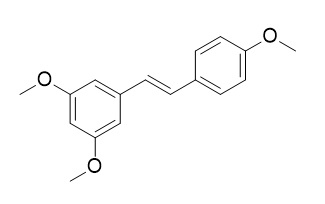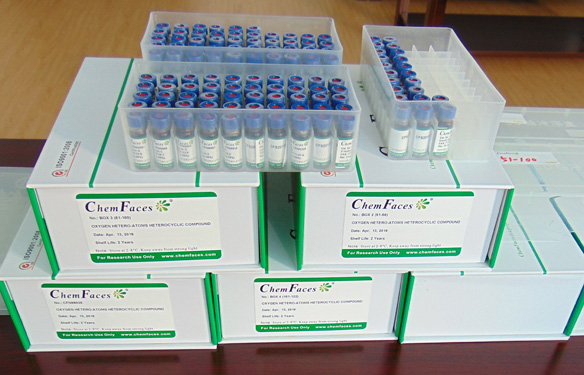3,4',5-Trimethoxystilbene
3,4',5-Trimethoxystilbene, an inhibitor of tubulin polymerization, which exerts antitumor, anti-HCV, antiallergic, anti-mitotic properties, it also exerts antiangiogenic and vascular-disrupting effects in zebrafish through the downregulation of VEGFR2 and cell-cycle modulation. 3,4',5-Trimethoxystilbene has anti-inflammatory activity, the ability of it to induce HO-1 expression may provide one of possible mechanisms of its anti-inflammatory action.
Inquire / Order:
manager@chemfaces.com
Technical Inquiries:
service@chemfaces.com
Tel:
+86-27-84237783
Fax:
+86-27-84254680
Address:
1 Building, No. 83, CheCheng Rd., Wuhan Economic and Technological Development Zone, Wuhan, Hubei 430056, PRC
Providing storage is as stated on the product vial and the vial is kept tightly sealed, the product can be stored for up to
24 months(2-8C).
Wherever possible, you should prepare and use solutions on the same day. However, if you need to make up stock solutions in advance, we recommend that you store the solution as aliquots in tightly sealed vials at -20C. Generally, these will be useable for up to two weeks. Before use, and prior to opening the vial we recommend that you allow your product to equilibrate to room temperature for at least 1 hour.
Need more advice on solubility, usage and handling? Please email to: service@chemfaces.com
The packaging of the product may have turned upside down during transportation, resulting in the natural compounds adhering to the neck or cap of the vial. take the vial out of its packaging and gently shake to let the compounds fall to the bottom of the vial. for liquid products, centrifuge at 200-500 RPM to gather the liquid at the bottom of the vial. try to avoid loss or contamination during handling.
Sci Rep.2023, 13(1):13610.
Ind Crops Prod.2015, 67:185-191
JLiquid Chromatography & Related Tech.2021, 10826076.
Food Analytical Methods2020, 1-10
Kaohsiung J Med Sci.2024, 40(3):280-290.
Toxins (Basel).2021, 13(12):898.
Plant Physiol Biochem.2023, 201:107795.
Food Chem.2019, 279:80-87
Int J Biol Sci.2023, 19(10):3077-3098.
Environ Toxicol.2024, tox.24246
Related and Featured Products
Toxicol Appl Pharmacol. 2015 Aug 15;287(1):67-76.
Structural modification of resveratrol leads to increased anti-tumor activity, but causes profound changes in the mode of action.[Pubmed:
26044878 ]
(Z)-3,5,4'-Trimethoxystilbene (3,4',5-Trimethoxystilbene, Z-TMS) is a resveratrol analog with increased antiproliferative activity towards a number of cancer cell lines compared to resveratrol, which has been shown to inhibit tubulin polymerization in vitro. The purpose of this study was to investigate if Z-TMS still shows potential for the prevention of metabolic diseases as known for resveratrol.
METHODS AND RESULTS:
Cell growth inhibition was determined with IC50 values for Z-TMS between 0.115μM and 0.473μM (resveratrol: 110.7μM to 190.2μM). Flow cytometric analysis revealed a G2/M arrest after Z-TMS treatment, whereas resveratrol caused S phase arrest. Furthermore, Z-TMS was shown to impair microtubule polymerization. Beneficial effects on lipid accumulation were observed for resveratrol, but not for Z-TMS in an in vitro steatosis model. (E)-Resveratrol was confirmed to elevate cAMP levels, and knockdown of AMPK attenuated the antiproliferative activity, while Z-TMS did not show significant effects in these experiments. SIRT1 and AMPK activities were further measured indirectly via induction of the target gene small heterodimer partner (SHP). Thereby, (E)-resveratrol, but not Z-TMS, showed potent induction of SHP mRNA levels in an AMPK- and SIRT1-dependent manner, as confirmed by knockdown experiments. We provide evidence that Z-TMS does not show beneficial metabolic effects, probably due to loss of activity towards resveratrol target genes. Moreover, our data support previous findings that Z-TMS acts as an inhibitor of tubulin polymerization.
CONCLUSIONS:
These findings confirm that the methylation of resveratrol leads to profound changes in the mode of action, which should be taken into consideration when conducting lead structure optimization approaches.
Biofactors. 2014 Jan-Feb;40(1):138-45.
Differential effects of resveratrol and its natural analogs, piceatannol and 3,5,4'-trans-trimethoxystilbene, on anti-inflammatory heme oxigenase-1 expression in RAW264.7 macrophages.[Pubmed:
23861314 ]
METHODS AND RESULTS:
Resveratrol (Res) and its two natural analogs that are also related to Res metabolism, piceatannol (Pic) and 3,5,4'-trans-trimethoxystilbene (3,4',5-Trimethoxystilbene ,TMS), were compared in their ability to suppress lipopolysaccharide (LPS)-induced production of proinflammatory tumor necrosis factor-α (TNF-α) and interleukin-1β (IL-1β) and to induce anti-inflammatory heme oxygenase-1 (HO-1) expression in RAW264.7 macrophages.
At non-cytotoxic concentrations, they differentially suppressed LPS-induced production of TNF-α and IL-1β; the relative potency for suppression of TNF-α and IL-1β production was Pic > Res > TMS. Res and Pic differentially induced HO-1 expression; Pic, which possesses four hydroxyl groups, was more active in inducing HO-1 expression than Res that contains three hydroxyl groups. TMS, which has none of hydroxyl groups, failed to induce HO-1 expression. These findings suggest that the hydroxyl groups of Res analogs are important for suppression of TNF-α and IL-1β production and HO-1 expression. Interestingly, protoporphyrin-IX, a competitive inhibitor of HO-1 activity, partly attenuated the inhibitory effects of Res and Pic (but not TMS) on TNF-α and IL-1β production, suggesting that suppression of TNF-α and IL-1β production correlates at least in part with HO-1 expression.
CONCLUSIONS:
Overall, the ability of Res analogs to induce HO-1 expression may provide one of possible mechanisms of their anti-inflammatory action.
Int J Pharm. 2010 Mar 30;388(1-2):144-50.
beta-Cyclodextrins influence on E-3,5,4'-trimethoxystilbene absorption across biological membrane model: a differential scanning calorimetry evidence.[Pubmed:
20045042 ]
E-3,5,4'-trimethoxystilbene (TMS) is a naturally occurring analog of resveratrol. The anti-neoplastic, antiallergic and anti-angiogenic activities of TMS have been recently reported.
METHODS AND RESULTS:
From the viewpoint of metabolism, TMS may be more favourable than resveratrol because all of its hydroxyl groups, which are subjected to extensive glucuronide or sulphate conjugation in the metabolic pathways of resveratrol, are protected by methylation. Moreover, methylation increases lipophilicity and may enhance cell membrane permeability, but it decreases its solubility in aqueous media. A way to increase TMS solubility can be represented by complexation with beta-cyclodextrins. In the present paper, the differential scanning calorimetry technique has been used to study the interaction of TMS with a biomembrane model constituted by dimyristoylphosphatidylcholine multilamellar vesicles. Furthermore, kinetic experiments have been carried out to follow the uptake of TMS by biomembranes in the presence of beta-cyclodextrins to gain information on the effect of beta-cyclodextrins on the uptake process.
CONCLUSIONS:
Our results indicate that opportune concentrations of beta-cyclodextrins greatly improve the uptake of TMS by biomembrane models.
Cancer Res. 2016 Aug 15;76(16):4887-96.
(Z)-3,5,4'-Trimethoxystilbene Limits Hepatitis C and Cancer Pathophysiology by Blocking Microtubule Dynamics and Cell-Cycle Progression.[Pubmed:
27287718]
Hepatocellular carcinoma (HCC) is the third most common cause of cancer-related deaths worldwide. Chronic hepatitis C virus (HCV) infection causes induction of several tumors/cancer stem cell (CSC) markers and is known to be a major risk factor for development of HCC. Therefore, drugs that simultaneously target viral replication and CSC properties are needed for a risk-free treatment of advanced stage liver diseases, including HCC.
METHODS AND RESULTS:
Here, we demonstrated that (Z)-3,5,4'-trimethoxystilbene (3,4',5-Trimethoxystilbene ,Z-TMS) exhibits potent antitumor and anti-HCV activities without exhibiting cytotoxicity to human hepatocytes in vitro or in mice livers. Diethylnitrosamine (DEN)/carbon tetrachloride (CCl4) extensively induced expression of DCLK1 (a CSC marker) in the livers of C57BL/6 mice following hepatic injury. Z-TMS exhibited hepatoprotective effects against DEN/CCl4-induced injury by reducing DCLK1 expression and improving histologic outcomes. The drug caused bundling of DCLK1 with microtubules and blocked cell-cycle progression at G2-M phase in hepatoma cells via downregulation of CDK1, induction of p21(cip1/waf1) expression, and inhibition of Akt (Ser(473)) phosphorylation. Z-TMS also inhibited proliferation of erlotinib-resistant lung adenocarcinoma cells (H1975) bearing the T790M EGFR mutation, most likely by promoting autophagy and nuclear fragmentation.
CONCLUSIONS:
In conclusion, Z-TMS appears to be a unique therapeutic agent targeting HCV and concurrently eliminating cells with neoplastic potential during chronic liver diseases, including HCC. It may also be a valuable drug for targeting drug-resistant carcinomas and cancers of the lungs, pancreas, colon, and intestine, in which DCLK1 is involved in tumorigenesis.
Biochim Biophys Acta. 2015 Feb;1853(2):377-87.
Novel role for TRPC4 in regulation of macroautophagy by a small molecule in vascular endothelial cells.[Pubmed:
25476892 ]
Macroautophagy (autophagy) is an important factor affecting the function of vascular endothelial cells (VECs) and must be tightly regulated in these cells. However, the precise mechanisms underlying this process, particularly in the presence of serum, remain obscure.
METHODS AND RESULTS:
In this study, we identified trans-3,5,4'-trimethoxystilbene (TMS) as a potent small molecule inducer of autophagy in human umbilical vascular endothelial cells (HUVECs) in the presence of serum. Using high-throughput DNA microarray and siRNA transfection technologies, we demonstrated that TMS induced autophagy by up-regulating the expression of the transient receptor potential canonical channel 4 (TRPC4), an important cation channel in HUVECs. In addition, the overexpression of TRPC4 by plasmid transfection also induced autophagy. Mechanistic studies revealed that the up-regulation of TRPC4 increased the intracellular Ca²⁺ concentration, which, in turn, activated the Ca²⁺/CaMKKβ/AMPK pathway, leading to mTOR inhibition and autophagy.
CONCLUSIONS:
Our study identifies a novel role for TRPC4 in the regulation of autophagy in VECs. TMS is a useful new tool for investigating the molecular mechanism of autophagy in VECs and may serve as a potential lead compound for developing a class of autophagy inducers to treat autophagy-related diseases.
Biofactors. 2006;27(1-4):37-46.
Anti-mitotic properties of resveratrol analog (Z)-3,5,4'-trimethoxystilbene.[Pubmed:
17012762]
METHODS AND RESULTS:
(Z)-3,5,4'-Trimethoxystilbene(3,4',5-Trimethoxystilbene) is a natural polyphenol present in five different plants, Virola cuspidata, Virola elongata, Centipeda minima, Schoenus nigricans and Rheum undulatum.
This molecule was prepared in a three-step sequence in good overall yield. The isomerisation from the (E)- to (Z)-isomer is performed using UV irradiation. Biological investigations were conducted on a human colon cancer cell line (Caco-2) with anti-mitotic activities. Growth was completely arrested at an added 0.4 microM level of (Z)-3,5,4'-trimethoxystilbene(3,4',5-Trimethoxystilbene).
CONCLUSIONS:
This agent is 100-fold more active than resveratrol or (E)-3,5,4'-trihydroxystilbene(3,4',5-Trimethoxystilbene), and the mechanism of this process involves an inhibition of tubulin polymerisation in a dose dependent manner.



